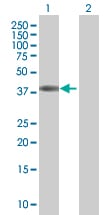EpCAM overexpression 293T lysate (whole cell) (ab94133)
Overview
-
Product name
EpCAM overexpression 293T lysate (whole cell)
See all EpCAM lysates -
General notes
ab94133 is a 293T cell transfected lysate in which Human EpCAM has been transiently over-expressed using a pCMV-EpCAM plasmid. The lysate is provided in 1X Sample Buffer. Note: For more details about how the transfected lysate was prepared view preparation notes
-
Tested applications
Suitable for: WBmore details
Properties
-
Mycoplasma free
Yes -
Form
Liquid -
Storage instructions
Shipped on dry ice. Upon delivery aliquot and store at -20ºC. Avoid freeze / thaw cycles. -
Storage buffer
Constituents: 0.01% Bromophenol blue, 2.3% Beta mercaptoethanol, 2% Sodium lauryl sulfate, 0.788% Tris HCl, 10% Glycerol (glycerin, glycerine) -
 Concentration information loading...
Concentration information loading... -
Research areas
-
Background
Function: May act as a physical homophilic interaction molecule between intestinal epithelial cells (IECs) and intraepithelial lymphocytes (IELs) at the mucosal epithelium for providing immunological barrier as a first line of defense against mucosal infection. Plays a role in embryonic stem cells proliferation and differentiation. Up-regulates the expression of FABP5, MYC and cyclins A and E. Tissue specificity: Highly and selectively expressed by undifferentiated rather than differentiated embryonic stem cells (ESC). Levels rapidly diminish as soon as ESC's differentiate (at protein levels). Expressed in almost all epithelial cell membranes but not on mesodermal or neural cell membranes. Found on the surface of adenocarcinoma. Disease: Defects in EPCAM are the cause of diarrhea type 5 (DIAR5) [MIM:613217]. It is an intractable diarrhea of infancy characterized by villous atrophy and absence of inflammation, with intestinal epithelial cell dysplasia manifesting as focal epithelial tufts in the duodenum and jejunum. Defects in EPCAM are a cause of hereditary non-polyposis colorectal cancer type 8 (HNPCC8) [MIM:613244]. HNPCC is a disease associated with marked increase in cancer susceptibility. It is characterized by a familial predisposition to early-onset colorectal carcinoma (CRC) and extra-colonic tumors of the gastrointestinal, urological and female reproductive tracts. HNPCC is reported to be the most common form of inherited colorectal cancer in the Western world. Clinically, HNPCC is often divided into two subgroups. Type I is characterized by hereditary predisposition to colorectal cancer, a young age of onset, and carcinoma observed in the proximal colon. Type II is characterized by increased risk for cancers in certain tissues such as the uterus, ovary, breast, stomach, small intestine, skin, and larynx in addition to the colon. Diagnosis of classical HNPCC is based on the Amsterdam criteria: 3 or more relatives affected by colorectal cancer, one a first degree relative of the other two; 2 or more generation affected; 1 or more colorectal cancers presenting before 50 years of age; exclusion of hereditary polyposis syndromes. The term 'suspected HNPCC' or 'incomplete HNPCC' can be used to describe families who do not or only partially fulfill the Amsterdam criteria, but in whom a genetic basis for colon cancer is strongly suspected. Note=HNPCC8 results from heterozygous deletion of 3-prime exons of EPCAM and intergenic regions directly upstream of MSH2, resulting in transcriptional read-through and epigenetic silencing of MSH2 in tissues expressing EPCAM. Similarity: Belongs to the EPCAM family. Contains 1 thyroglobulin type-1 domain. PTM: Hyperglycosylated in carcinoma tissue as compared with autologous normal epithelia. Glycosylation at Asn-198 is crucial for protein stability.
Images
-
ab94133 at 15µg/lane on an SDS-PAGE gel.
-
All lanes : Anti-EpCAM antibody (ab88684) at 1/500 dilution
Lane 1 :EpCAM overexpression 293T lysate (whole cell) (ab94133)
Lane 2 : 293T non-transfected lysate
Lysates/proteins at 25 µg per lane.
Secondary
All lanes : Goat Anti-mouse IgG (H and L) HRP conjugated at 1/2500 dilution










